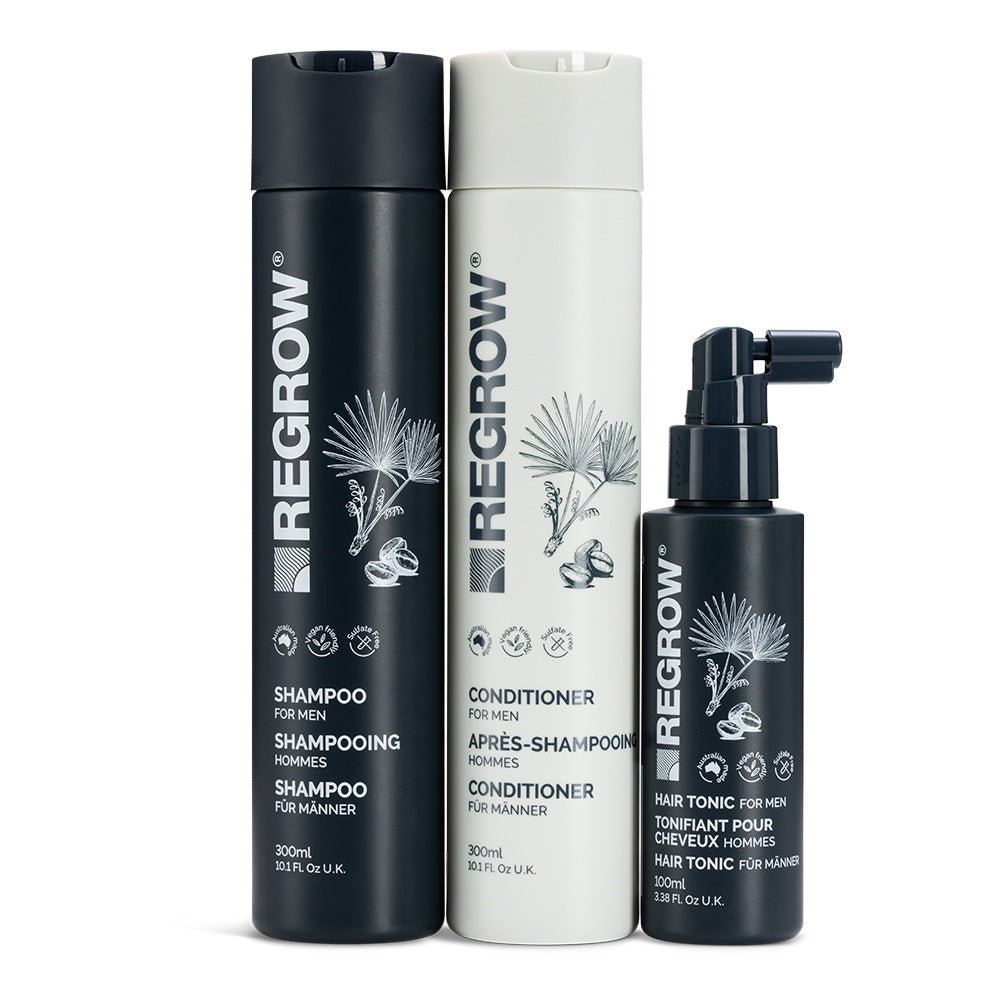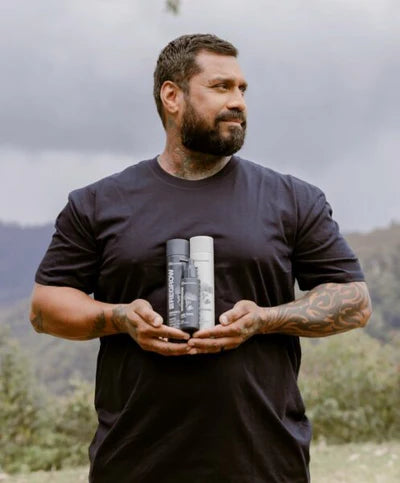
Regrow can help
When we speak with our male customers about hair loss and products available, they usually have the same three questions:
- Why am I losing my hair?
- Does it work?
- Where can I buy it?
We know that men don’t have the time, nor the inclination to sift through hundreds of products to find one they can trust. So, let’s just get straight to the point.

Does Regrow work?
Many people see positive results when using REGROW as part of a consistent hair care routine, especially when they start early. Our formulas are made with scientifically researched, naturally inspired ingredients — you can read more about them here.
Everyone’s hair journey is unique, and results can vary. For some advanced stages of hair loss, combining REGROW with other hair care approaches may be beneficial. If you’re considering other options, such as a transplant, Regrow can still play a role in helping to keep your scalp healthy and your existing hair in great condition.
Why is my hair falling out?
Poor Circulation
Firstly, you aren’t alone, up to 70% of men (and a surprising 80% of women) will experience hair loss in their lifetime! Plus, it can start as young as 13! But don’t worry, we’ve got your back, they say knowledge is power, and we are here to inform.
On the whole, there are a lot of reasons why your hair is falling out, but it all comes down to two main factors for most men:
DHT and poor blood circulation to the hair follicles.

DHT
DHT
Dihydrotestosterone (DHT) is made from testosterone by an enzyme called 5-alpha-reductase (5AR) which latches onto the base of your follicle and constantly grows. As it grows, your follicle shrinks, eventually making the hair fall out. Regrow aims to stunt the growth of DHT by using high-grade Saw Palmetto and Caffeine which are known DHT blockers. Regrow=1, DHT=0. Winning!
Poor Circulation
Poor Circulation
Your hair needs a steady supply of nutrients to stay strong. Those nutrients travel through tiny blood vessels in your scalp. If that flow slows down, hair can start to look thinner or weaker. Factors like genetics, age, stress, and lifestyle can all play a part — so looking after your scalp health is key.
What are the different types of hair loss?
Keep reading below to see which form of hair loss you may be experiencing.
What is Androgenetic Alopecia?
What is Androgenetic Alopecia?
Or should I say, what is male pattern baldness? Male pattern baldness is the most common form of hair loss in men, and it occurs gradually over time. Hair is lost in a well-defined area, starting above temples and from fringe to crown, overtime receding in an ‘M’ shape at the front of the hair line. This can lead to partial or complete baldness, this is fine if you look like The Rock, Vin Diesel or Jason Stratham, but not all of us can pull this look off. We suggest you look at the Men’s Shampoo, Conditioner and Tonic (the Extra Tonic Pack would be ideal here). No messing around, let’s just get it happening.
What is Traction Alopecia?
What is Traction Alopecia?
Everyday strain on the hair — from hard hats, tying it back too tight, heavy dreadlocks, or harsh styling chemicals — can weaken follicles over time. If caught early, you can help prevent further damage by reducing the stress on your hair. Look at what might be causing it and make changes — choose quality styling products, avoid tight styles, and consider lightening heavy hairstyles such as dreadlocks. Acting early can help keep your hair looking stronger for longer.
What is Telogen Effluvium?
What is Telogen Effluvium?
This is a rapid shedding of hair caused by major stress in the body such as surgery or rapid weight loss. You may want to have a chat to your doctor just to make sure everything is ok if your hair is coming out really fast. Once diagnosed properly, this is considered a temporary condition and only comes after the body receives some kind of shock to the system. We still recommend using our Regrow products, for healthy, strong hair.
Grab one of our Men’s 3 Month Treatment Programmes.
What is Anagen Effluvium?
What is Anagen Effluvium?
Not to be confused with Telogen Effluvium, it can also a rapid shedding of hair however it is during the growth cycle (Anagen). This can happen due to medications such as chemotherapy or other drugs, toxins, radiation or to individuals with an autoimmune disease. Basically, anything that causes a disruption with the cell division in your hair making the hair narrower at the base and more likely to break or fall out. Whilst under medical treatment, such as chemotherapy, Anagen Effluvium can’t be fixed however the hair should start to grow back between 3 to 6 months after finishing. Regrow can help your hair come through healthy and strong.
Grab one of our Men’s 3 Month Treatment Programmes.
Still want more info? Sign up to our newsletter so you can be first to see our blogs and promotions.











